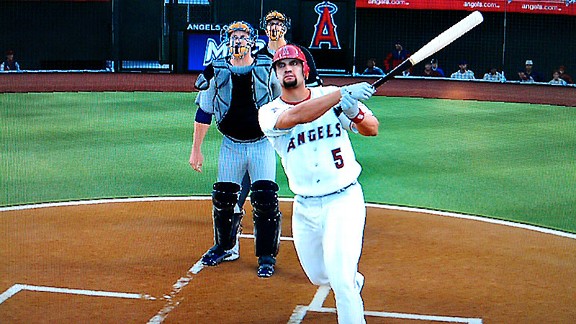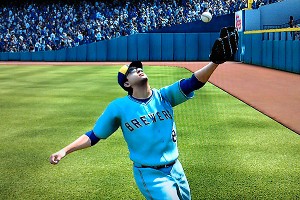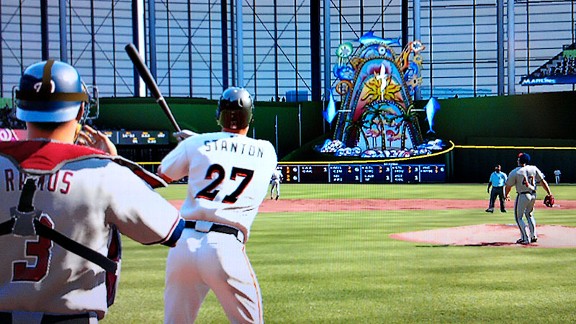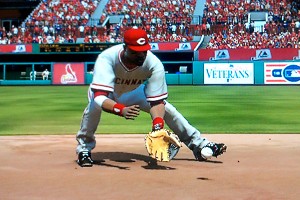Miguelito Kache305's Blog


Each year, Sony Computer Entertainment America and San Diego Studio produces the best sports video game available and each year those developers find a way to make their game better. Tuesday's release of MLB 12 The Show will demonstrate this but even this franchise's most dedicated followers will immediately recognize they are seeing a game they've never seen before. Put away your previous versions of the MLB The Show series: For 2012, the bar has again been raised, and this time with vigor.
The game's programmers have completely replaced last year's code and thus changed the way the baseball behaves with what they call True Ball Physics, which uses actual math for a spinning baseball that ricochets off bases, the pitching rubber and other field surfaces. The spin of the baseball off the bat is now accurate with realistic RPMs and the ball gains or loses energy like a real baseball, resulting in more hit type varieties. Line drives rise or sink and infield chops quickly become difficult to handle. My friend John Totten and I have played countless The Show games over the years, so I asked him for his '12 version impressions after a day of heated, head-to-head competition.
"Hitting a hooking line drive just inside the left-field line was something I had never seen before, and introduced an element of the unknown that I do not recall experiencing often in previous games," he said. "The overspin/underspin of a groundball based on the level of contact was an excellent added subtlety. I was surprised when a groundball did not make it through the infield, especially up the middle. Those balls simply lost pace due to underspin, as they should have. Line drives to the outfield showed tail and hook. In the past, every line drive to the outfield stayed on the same trajectory."
Trust me when I say this; Given the way the ball now spins in MLB 12 The Show, you will value the defensive abilities of your fielders as never before. Outfield defense was especially adventurous and fielding line drives or chasing balls in the gaps and down the lines is more challenging.
[+] Enlarge
 MLB 12 The Show Defense is more difficult in MLB 12 The Show, but that doesn't mean you can't get Ryan Braun to make catches like this.
MLB 12 The Show Defense is more difficult in MLB 12 The Show, but that doesn't mean you can't get Ryan Braun to make catches like this.The game acts, looks and sounds unlike the series has before; from completely different bat, ball and glove sounds to the TruBroadcast Presentations, which are available only on the game's PS3 version. The line between watching the video game and watching an actual baseball game has been blurred using new camera angles and audio that realistically simulate a television broadcast. You'll see more reaction shots after pitches and hear a new "buzz" of the ball and "pop" of a catcher's mitt while a bouncing, spinning baseball hitting green grass sounds just as it should.
Among MLB 12 The Show's many other changes I liked was the Swing/Pitch info box, which now pops up automatically after each pitch and remains onscreen until the next pitch, no more pressing L3 every time you want feedback. Baserunners have new situational awareness and react differently when near a batted ball or another player. Bullpen management continues its brilliant evolution. You can now warm up a relief pitcher or simply select Stretch and Toss, which has the pitcher stretch and play catch without getting warm enough to enter the game. You can also save a reliever's energy once he does begin to warm up by selecting Ready and Waiting, which has the pitcher throw a pitch in the bullpen for every game pitch thrown to maintain readiness. No more overheating relievers before they get into the game.
As always, there are new systems with which to pitch and hit the ball. Let me go on record: I hate them. I'm a button man; always have been and always will be. Last year The Show introduced analog batting featuring a stride and swing method. MLB 12 The Show has advanced to Zone Analog Batting, which allows you to control where you swing in the zone with the left analog stick as you step into the pitch and swing with the right analog stick. Sound hard? It is. I hit like a blindfolded Mario Mendoza and gave up. However, if you were a fan of analog hitting in last year's version you'll enjoy it all the more this year.
New as well is Pulse Pitching, an interactive timing mechanic with an interface that consists of a pulsating circle that flashes around the baseball as you are adjusting the desired location of your pitch. With this method you try and hit the X button when the meter shrinks to the smallest possible size around the baseball. This controls the accuracy of your pitches; the smaller the cursor the more accurate the pitch will be, with the speed of the meter's pulsating depending on the game difficulty setting and the pitcher's attributes and performance.
This feature fails for two reasons: First, it gives you a throbbing headache after about two innings of staring at it, but more importantly your opponent can see exactly how close each pitch came to its ideal location as both players see the size of the pulsating meter around the ball. The player who is batting, seeing a wide meter around the baseball as the pitch is being delivered, instantly knows that the command of the pitch will be poor and is therefore given a clear sign that he doesn't need to swing. This is not a factor with the traditional pitching meter but in the case of Pulse Pitching, when both players are focused on the strike zone, it seems the video equivalent of the guy in the white T-shirt in Toronto's center-field bleachers: a giveaway.
MLB 12 The Show has a complete set of visual tutorials for all new methods of hitting, pitching and throwing and it speaks to what has always been The Show series' greatest strength: It never FORCES you to change the way you play the game. Every year, new controls are added or enhanced while always leaving you the option of staying with the buttons and systems that you've always enjoyed, a practice that other sports video franchises, like EA's Madden or NCAA Football has not always followed. My friend Gus Ramsey's annual review of Madden on Bill Simmons' podcast has become one of The Sports Guy's biggest hits.
"Since around 2004 the look of the Madden franchise has been almost the same, but the game play has changed in an effort to make the game more realistic," Gus says. "Sometimes to great success, other times, not so much. In '04 they added the ability to direct the lead blocker on runs, a true challenge of digital dexterity to be sure. In '06 they added the Truck Stick, a departure from the popular R1 juke button. '06 also brought on the hideous Passing Cone, the New Coke of video game experiments. We've also seen the elimination of the sprint button, which left players instinctually pressing the R2 button with no results."
I donít recall MLB The Show developers ever demanding you change your button options or patterns, always offering new variations but never abandoning preferred methods enjoyed over time. A great lesson for all developers of sports video games: You can offer all the new ideas you want but don't force me to switch my buttons or I'll be forced to stop buying your game.
 MLB 12 The Show You won't want to miss seeing Giancarlo Stanton mashing home runs in his new home ballpark.
MLB 12 The Show You won't want to miss seeing Giancarlo Stanton mashing home runs in his new home ballpark.The Show is a series that strives for authenticity yet pitcher repertoires is one area the developers consistently seem to miss their mark. In 2011 Boston's Daniel Bard threw 68.7 percent fastballs, 24.8 percent sliders and 6.5 percent changeups. Bard's weapons were essentially a four-seam fastball, a two-seam fastball and a slider. As the numbers prove, he rarely threw a changeup and often limited himself to just the four-seamer or slider in a game's most crucial points. In MLB 12 The Show, however, Bard has FIVE pitches: four-seam fastball, slider, cutter, two-seam fastball and a circle change. Bard admits he'll have to mix in more two-seam fastballs and changeups as he moves from the Red Sox bullpen to the rotation but five pitches for a guy who essentially has relied on two is a swing and a miss at realism. It gets worse.
In 2011, Mariners closer Brandon League threw 67.4 percent sinkers, 21.3 percent split-finger fastballs and 11.3 percent sliders. With two strikes, League went to his splitter a whopping 40 percent of the time. It is his big "out pitch" and one of the effective splitters in baseball; except in MLB 12 The Show, where both League's splitter and sinker don't exist. Nor does the cut fastball of Diamondbacks reliever Bryan Shaw, which earlier this spring Arizona closer J.J. Putz compared to Mariano Rivera's. Last season, 58.3 percent of all pitches thrown by Shaw were cut fastballs. MLB 12 The Show does not include a cutter among Shaw's three pitches, unfortunate for a pitcher who in last season's NLDS spotlight appeared in four games and faced 13 batters without giving up a base hit.
[+] Enlarge
 MLB 12 The Show Watch those tricky hops!
MLB 12 The Show Watch those tricky hops!This is not just a pitch selection issue. Clevelandís Vinnie Pestano last season had an immensely effective combination of 79.9 percent fastballs and 20.1 percent sliders. Pestano's fastball, which is actually a cutter, averaged 92.6 miles per hour and maxed at 95.5 mph. In MLB 12 The Show, not only does Pestano not possess a cutter, his four-seam fastball is just 88 mph. Pestano joked during our Twitter conversation, "Don't know whats more upsetting ... that my 2 seamer is harder than my 4 or my pitching clutch is only 54. #pickitupdigitalme." Pestano's fellow Indians reliever Joe Smith joked, "That's what you get for being a righty specialist."
Smith enjoys The Show series but is used to seeing his digital repertoire miss the mark. In 2011, the real Smith threw 69 percent sinkers and 31 percent sliders. In MLB 12 The Show, Smith's video game version doesn't possess a sinker. He's instead been given a four-seam fastball and a changeup, two pitches he doesn't throw. "With guys who have been around for a few years and the big names in the game they are pretty accurate," said Smith. "Young guys seem to have to 'pay their dues' so to speak before they give them really high ratings. But I would say all in all they do an excellent job."
Agreed. Pitch selection nitpicking aside, MLB 12 The Show is not just a step forward for the series but a broad jump. This year in Road to The Show, your player will begin as a touted Double-A prospect. As of this weekend, the servers were still being tuned so I was not able to sample the game's new Diamond Dynasty mode, but based on advance publicity if you're a fan of EA's FIFA Soccer Franchise's Ultimate Team mode you'll be thrilled with Diamond Dynasty, which allows gamers to create personalized team names, colors, uniforms and fully customizable logos with up to 1000 layers of detail. As for baseball's new 10-team playoff format, the developers tell me they're not ready to make a public comment yet and will address the issue when they feel the time is right, choosing instead to let the game's new features "have their day in the sun."
There may be occasions in which you'd be rightfully content to continue playing a previous year's version of a sports video game rather than committing the cash to buy the new edition. With MLB 12 The Show, this is not one of those years. This is a different game than the series has ever seen and is beyond a doubt its best yet.
Miguelito Kache305
12
Miguelito Kache305's Blog Categories
Miguelito Kache305's Screenshots (0)

Miguelito Kache305 does not have any albums to display.
More
Miguelito Kache305's Friends
Recent Visitors
The last 10 visitor(s) to this Arena were:
Miguelito Kache305's Arena has had 37,238 visits
- floppdiddy
- krva24
- LokioRa
- marlinsjake16
- mikemck09
- niharjhatn
- SmittyD81
- SodaPopinski
- TecmoZack
- VUUAASSHHH!
Miguelito Kache305's Arena has had 37,238 visits



I would guess that would be fairly easy to correct.